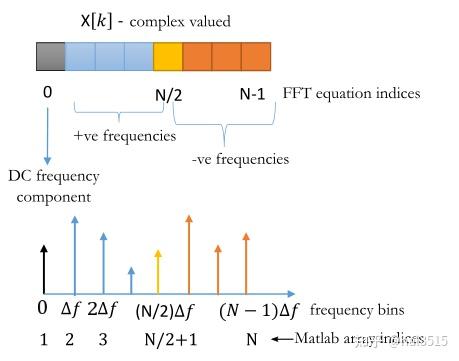Signals & Systems Projects
Project
1:Matched filtering of Linear Frequency Modulated (LFM) signal
线性调频信号的匹配滤波
FFT function
 fig01
fig01
Parameters: 1. sampling time:
2. sampling rate: 3.
4. frequency index: 5. original
index: (same as 3.)


Generating Original Waves
According to the Euler's formula, we can get:
The real part of the signal is:
The imaginary part of the signal is:
1
2
3
4
5
6
7
8
9
10
11
12
13
14
15
16
17
18
19
20
21
22
23
24
| T=10e-6;
B=40e6;
K=B/T;
Fs=2*B;Ts=1/Fs;
N=T/Ts;
t=linspace(-T/2,T/2,N);
St=exp(1i*pi*K*t.^2);
figure(1)
subplot(311)
plot(t*1e6,real(St));
xlabel('time/us');
title('waveform of LFM signal real part');
grid on;axis tight;
subplot(312)
plot(t*1e6,imag(St));
xlabel('time/us');
title('waveform of LFM signal imaginiary part');
grid on;axis tight;
subplot(313)
freq=linspace(-Fs/2,Fs/2,N);
plot(freq*1e-6,fftshift(abs(fft(St))));
xlabel('f/MHz');
title('corresponding amplitude spectrum');
grid on;axis tight;
|
Matched filtering
1
2
3
4
5
6
7
8
9
10
11
12
13
14
15
16
17
18
19
20
21
22
23
| St_wgn = awgn(St,10);
Ht = conj(fliplr(St));
yt = conv(St_wgn, Ht) ;
yf = Sf.*Hf ;
t_0=linspace(-T/2,T/2,2*N-1);
freq=linspace(-Fs/2,Fs/2,2*N-1);
figure(2)
subplot(311)
plot(t_0*1e6,real(yt));
xlabel('time/us');
title('real part of output signal');
grid on;axis tight;
subplot(312)
plot(t_0*1e6,imag(yt));
xlabel('time/us');
title('imaginary part of output signal');
grid on;axis tight;
subplot(313)
plot(freq*1e-6,fftshift(abs(fft(yt))));
xlabel('f/MHz');
title('corresponding amplitude spectrum of output signal');
grid on;axis tight;
|
Principle Analysis
考虑观测信号:
为已知信号,为零均值的加性平稳噪声(白色或有色)
令为滤波器的时不变冲激响应函数,目标就是设计滤波器,使得滤波器的输出信号的信噪比最大化。
滤波器的输出信号为:
、分别为滤波器的输出信号分量和噪声信号分量。
在时刻,滤波器的输出信噪比定义为
利用傅里叶变换的卷积特性,有
式中, = 为滤波器的频率响应函数(传递函数), = 为信号的频谱密度函数。
时刻,输出信号的瞬时功率为
时刻,输出噪声的平均功率为
补一些功率谱密度的知识: 若某一个功率信号的功率为,则有
其功率谱密度函数为
若以f为自变量,则可以写成
(其中为的傅里叶变换, 为在上的截断信号) 根据Parseval定理
总功率为:
令为加性噪声的功率谱密度函数,则输出噪声的功率谱密度函数为
输出噪声的平均功率可以写作(以频率作为量度)
代入信噪比定义式,可以得出
分子凑了一个,
因为要用到Cauchy-Schwartz不等式:
等号在当且仅当,
c是任意复常数时成立。取c = 1:
,
的模总是因此平方也是,复指数乘积项就没了进一步化简:
取最大值,即为等式成立条件。将式中等号成立时的滤波器传递函数记作,
利用Cauchy-Schwartz不等式等号成立条件:
可以得到最大信噪比:
由此,最优线性滤波器理论推导完成。
由题意得其功率谱也恒定为 .代入 中得到:
对其进行反变换,得到最优线性滤波器的时域表达式:
时,最优线性滤波器为:
对应题干中:,, 能得到N = 2. 该噪声的功率谱密度为1,该噪声为一个白噪声。
Conclusion
- 匹配滤波器的单位冲激响应是原信号的共轭反转信号
- 匹配滤波后的实部输出非常像Sinc Function 原因:输出信号的幅度:
当时,包络近似为辛格(sinc)函数。
- 输出幅度/功率在处有最大值(考虑延迟,则在)
Radar


